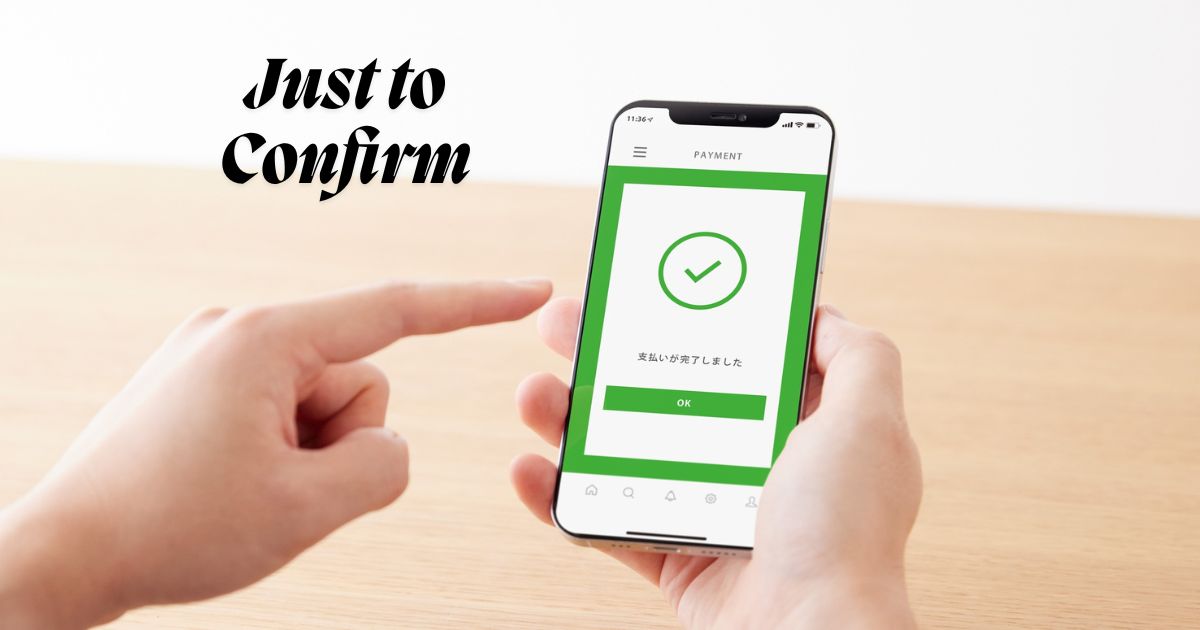Clear communication can make all the difference. That’s why saying Just to Confirm is a powerful tool. It shows you care about getting things right and avoiding costly mistakes. Whether you’re writing emails, joining meetings, or sending quick messages, using Just to Confirm keeps your tone professional and polite. This simple phrase helps make sure everyone is on the same page, no confusion, no guesswork.
People use Just to Confirm to double-check details and keep projects running smoothly. It supports better decision-making, stronger team collaboration, and effective communication every time. So, whenever you want to verify or reconfirm something, don’t hesitate to say Just to Confirm,it’s your key to clear, confident conversations.
Other Ways to Say “Just to Confirm”
If you want to vary your language, try alternatives like “For clarification,” “To verify,” or “Seeking confirmation.” These phrases help maintain a polite language and professional tone while ensuring communication effectiveness. Using different expressions keeps your messages fresh and aligns expectations clearly in both formal and informal communication.
1. For Clarification
Example: “For clarification, are we expected to submit the final report by Friday or next Monday?”
Meaning: This expression is used to request additional information or confirm specific details to avoid misunderstandings.
Usage: Ideal in professional emails, planning sessions, or official meetings when clarity in messaging and accurate information are essential.
2. To Ensure We’re on the Same Page
Example: “Just to ensure we’re on the same page, the client will handle the logistics, correct?”
Meaning: This phrase confirms mutual understanding between parties before moving forward.
Usage: Common in project alignment, team collaboration, and follow-up communications to align expectations and ensure a shared understanding.
3. To Verify
Example: “I’m emailing to verify the delivery address before we ship the order.”
Meaning: Used to check if a detail or piece of information is correct.
Usage: Suitable for both formal communication and light tone communication, especially when verifying information or checking details in emails.
4. For Confirmation Purposes
Example: “For confirmation purposes, could you resend the finalized agenda?”
Meaning: A polite way to request reaffirmation of important details or plans.
Usage: Best used in professional email language and official meetings to confirm details and promote communication effectiveness.
5. Just to Double-check
Example: “Just to double-check, we’re using the updated template for the presentation, right?”
Meaning: A casual, friendly way to ask for verification without sounding demanding.
Usage: Great for informal communication and interpersonal communication to confirm arrangements and maintain a respectful tone.
Read More: 12 Other Ways to Say “Making Things Right”
6. To Reaffirm
Example: “I’d like to reaffirm our plan to meet with the legal team next Thursday.”
Meaning: This shows a desire to reconfirm and express commitment to a prior agreement.
Usage: Effective in strategic decisions, team planning, or action confirmation where consensus and decision-making are critical.
7. Seeking Confirmation
Example: “I’m reaching out seeking confirmation on whether the invoice has been approved.”
Meaning: A direct yet polite way to ask someone to confirm something specific.
Usage: Works well in professional settings, especially in emails or project updates where confirming accuracy and communication tone matter.
8. To Reconfirm
Example: “Just calling to reconfirm our dinner reservation for 7 PM tonight.”
Meaning: A follow-up check to make sure earlier arrangements are still valid.
Usage: Useful in both professional and personal contexts to confirm arrangements or verbal agreements.
9. Can You Confirm
Example: “Can you confirm that the design files were uploaded to the shared drive?”
Meaning: A simple and direct way to ask if something has happened or is true.
Usage: Common in emails, project management tools, and team chats where clear communication and accurate information are necessary.
10. I Just Want to Check
Example: “I just want to check if you’re still available for tomorrow’s client call.”
Meaning: A softer, more casual way to ask for confirmation.
Usage: Great for maintaining a light tone communication style while still asking for confirmation in everyday team collaboration.
11. Could You Please Clarify
Example: “Could you please clarify what’s included in the second phase of the project?”
Meaning: A polite request for additional information to remove confusion.
Usage: Essential in formal communication, planning sessions, and when understanding scope is important for communication strategy.
12. Just for My Understanding
Example: “Just for my understanding, are we prioritizing the mobile launch over the desktop version?”
Meaning: Used to politely ask for clarification without implying that the other person was unclear.
Usage: Perfect for professional email language and team discussions where clarification supports interpersonal communication and project alignment.
When to Use Different Expressions
Using “Just to Confirm” is a polite and clear way to verify information and ensure mutual understanding in professional communication. It fits perfectly in emails, official meetings, and follow-up communications where confirming details or action confirmation is necessary. This phrase helps maintain a respectful tone while reinforcing clarity in messaging and avoiding misunderstandings. Whether you’re checking details, seeking agreement, or reaffirming plans, “Just to Confirm” supports effective communication and aligns expectations across teams, enhancing decision-making and project alignment.
Formal Contexts
In formal communication, using precise and polite language is essential to maintain professionalism and clarity. Phrases like “Just to Confirm” are especially useful in emails, official meetings, and planning sessions where verifying information and ensuring accurate details can impact strategic decisions. This expression helps reinforce information and promote consensus while aligning expectations among team members. Employing such language improves communication effectiveness and supports mutual understanding, which is crucial in professional settings and decision-making processes.
Seeking Agreement
When you want to secure a clear consensus or mutual understanding, especially in professional settings, using expressions like “Just to Confirm” helps keep communication polite and direct. This phrase is perfect for follow-up communications or emails where you need to confirm details, verify information, or reaffirm decisions. It ensures everyone is aligned and supports effective team collaboration, planning sessions, and project alignment by maintaining a respectful tone and clarity in messaging.
Casual Situations
In informal communication, “Just to Confirm” works well when you want to double-check or clarify plans without sounding too formal or stiff. Whether it’s a quick text, a casual email, or a light tone communication between colleagues or friends, this phrase helps ensure shared understanding while keeping the conversation friendly and approachable. Using it in casual settings strikes the right balance between politeness and simplicity, making interpersonal communication smooth and effective.
Direct Requests for Information
When you need precise information quickly, using “Just to Confirm” in direct requests is very effective. It helps verify details clearly without sounding overly formal or ambiguous. In professional settings, especially during emails or follow-up communications, this phrase sets a respectful tone while emphasizing clarity in messaging. It encourages the recipient to provide accurate information, reinforcing mutual understanding and ensuring communication effectiveness.
Clarifying Understanding
Using “Just to Confirm” when clarifying understanding helps ensure mutual understanding between all parties involved. It’s especially useful in professional email language and official meetings where precise information and shared understanding are essential for project alignment and decision-making. This phrase supports respectful tone and communication strategy by politely requesting clarification or reaffirming details, which strengthens team collaboration and reduces misunderstandings.
Conclusion
Using Just to Confirm is a smart way to keep communication clear. It helps you check details and avoid confusion. When you say Just to Confirm, you show respect and professionalism. This phrase fits well in emails, meetings, and casual talks. It makes sure everyone shares the same understanding. You must use Just to Confirm when you want accurate information or need to reconfirm plans.
Remember, good communication depends on clarity. Saying Just to Confirm often improves teamwork and decision-making. It also helps in formal communication and informal communication alike. You must include Just to Confirm in your messages to verify facts politely. So, next time you need to double-check or seek agreement, use Just to Confirm. It will make your communication stronger and more effective every time.
FAQ’s
What does Just to Confirm mean?
Just to Confirm means checking details to make sure information is correct. It helps avoid misunderstandings in communication.
When should I use Just to Confirm?
Use Just to Confirm when you want to verify facts or reconfirm plans. It works in emails, meetings, and casual conversations.
Is Just to Confirm formal or informal?
Just to Confirm fits both formal communication and informal communication. It keeps the tone polite and professional in all settings.
How does Just to Confirm improve communication?
Just to Confirm ensures accurate information and shared understanding. It boosts communication effectiveness and helps with team collaboration.
Can I use Just to Confirm in emails?
Yes, Just to Confirm is perfect for emails. It shows you respect clarity and want to confirm details politely.

Grammerroot is your trusted source for mastering English grammar and language skills. From simple rules to advanced tips, we help learners build strong foundations through easy-to-understand content. Learn smart, learn right — only at Grammer Root.




